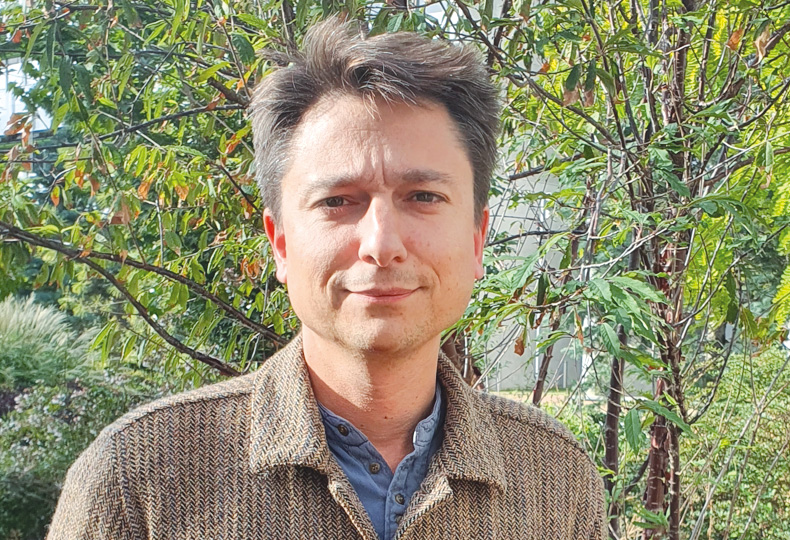Ulysse Baratin to lead the Research Stage

Since September 2022, its new director, Ulysse Baratin, has been responsible for ensuring its influence and affirming the singularity of the project by consolidating the artistic, scientific and cultural project.
Could you tell us a little about your background?
I first studied modern literature at the Sorbonne, which led me to spend a particularly memorable year at Carleton College (liberal arts college, Minnesota, USA). My favourite subject has always been the links between literature and social sciences.
This taste for the crossroads between disciplines and cultural organisations led me to join SciencesPo Paris, and to become a programmer at the theatre La Reine Blanche, Scène des arts et des sciences. I helped launch and run the theatre for seven years. The performing arts offer a particularly favourable terrain for meetings between scientists and artists. The accompaniment of these crossings and their realisation are at the heart of my career.
What does ENS Paris-Saclay mean to you?
First of all, it is a place of academic excellence and cutting-edge research, which brings science to an international level. I also see it as a place where great intellectual freedom can be exercised, with a taste for experimentation and the crossing of disciplines. If only because of its location, its general architecture, and the presence of the Scène de Recherche, the ENS Paris-Saclay has a strong experimental, even utopian, dimension.
The school seems to me to be both connected to contemporary issues and removed from the noise of the world. Among other things, research and artistic activity require this slight withdrawal, this reflexive distance that allows us to take a step back.
Can you tell us something about the programme?
This season is dedicated to unexpected encounters: visual arts and chemistry, dance and quantum physics, new magic and neuroscience, music and mineralogy, multimedia arts and robotics, sociology and theatre, theatre and cosmology... We come to the Scène de recherche to have experiences. They engage all our senses and provoke new questions. They open up perspectives we hadn't thought of.
¨For example, starting this week, Julien Avril will open the season with Effondré.e.s, a piece conceived in collaboration with the Mechanical Engineering department and students from all disciplines: it will be a question of seeing how, in the face of the climate crisis, to give a voice to non-humans, to fauna, plants and machines. This collective work may seem like science fiction, but it leads us to examine an issue that concerns us all.
Throughout the year, we will welcome Frédérique Aït-Touati. Her presence is an extraordinary opportunity because she is a specialist in the margins between art and science. Together with Bruno Latour, she is exploring ways of making climate change sensitive. In fact, the ecological question will punctuate the whole season, with artists who will multiply the points of view on this question.
What would be the biggest challenge for you in this position?
Opening the doors of the Research Stage wide! Thanks to the work of Agathe Bioulès, Marc Dondey and Pierre-Paul Zalio, to whom I would like to pay tribute, the Scène de recherche is now in orbit. But now it is a question of making it known and familiar to everyone. This place, which is a trademark, a formidable distinctive sign of the ENS Paris-Saclay and the University of Paris-Saclay, must now open up to the widest possible audience and meet the public.
This space belongs to the teacher-researchers, the students of ENS Paris-Saclay and the students of the University of Paris-Saclay. Whether it is to collaborate with artists in the framework of residencies, to participate in joint workshops, or to come and see our performances, the Scène de recherche (SDR) is a place for dialogue. In this respect, I think it is important to remember that the RDC will host one week a month of student artistic activities.
Opening the Scène de recherche to the wider community also means welcoming the Essonne, its inhabitants and school groups. This is both in the interests of cultural democratization and to raise awareness of the ENS Paris-Saclay.
A place where people meet, where languages cross, the Scène de recherche is a happy Tower of Babel. However, it is not an ivory tower: such a space can blossom and develop its many rich possibilities if everyone makes it their own. This is the objective that drives the Scène de recherche team.
The "Scène de recherche"
Located in the heart of the Paris-Saclay University campus, the Scène de recherche de l'École normale supérieure Paris-Saclay is a professional theatre aiming tò experiment with new ways of researching, training, creating. The equipment is atypical: a compact box, visible from the outside, a 160-seat performance hall as well as a research-creation platform.
The Scène de recherche brings together actors from artistic creation, scientific research, technological and social innovation around its project and in its transdisciplinary programmes.
It organises research and creation residencies and capsules, runs a training programme and offers a cultural programme open to the general public.
More broadly, the Scène de recherche aims to bring the artistic requirements and challenges of research and creation outside the walls of ENS Paris-Saclay, for the University and beyond.

